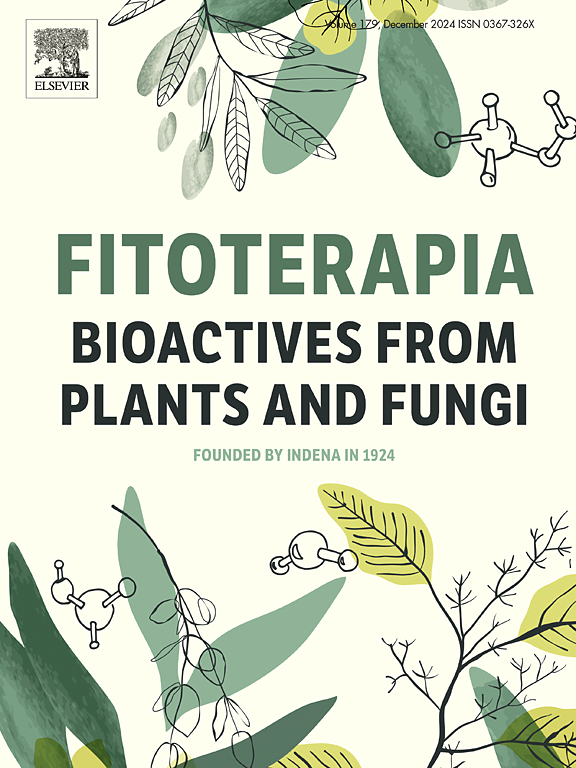Targeted isolation of new antibacterial sesquiterpene coumarins from ammoniacum (Ferula communis L.)
IF 2.6
3区 医学
Q3 CHEMISTRY, MEDICINAL
引用次数: 0
Abstract
The use of plant-based remedies in traditional medecine to combat bacterial infections has been scientifically studied. As part of an ongoing research for the discovery of new therapeutic options to treat bacterial infections, Ammoniacum gum resin from Ferula communis L. roots was explored. Ammoniacum appeared in many traditional formulations of Arab, Indian and Western medicines and its use has been reported throughout the centuries. This present study aimed to further explore this gum-resin using a molecular-networking-guided method for the accelerated discovery of new antibacterial compounds. HPLC-PDA-HRMS/MS molecular-networking-based dereplication strategy highlighted the presence of known sesquiterpene coumarins among potential new derivatives. By comparison of MS/MS fragmentation spectra between known and unknown compounds, a hydroxycinnamic sesquiterpene coumarin structure was predicted as a potential new compound. Mass-guided isolation followed by structural elucidation allowed us to corroborate the predicted structure of this new derivative identified as o-coumaric-ω-hydroxyferulenol (10). The new derivative showed MIC90 values of 1.84–6.17 μM against cutaneous Gram-positive bacteria with a bactericidal effect measured by MBC/MCI ratio evaluation and flow cytometry methodology. Furthermore, the new compound showed no in vitro cytotoxicity against eukaryotic cells. This study confirms the interest to analyse with modern techniques ancient traditional remedies in the exploration of new bioactive compounds with therapeutical potential.

从阿魏中靶向分离新型抗菌倍半萜香豆素
在传统医学中使用植物疗法来对抗细菌感染已经得到了科学的研究。作为一项正在进行的研究的一部分,发现新的治疗方案,以治疗细菌感染,从阿魏的根氨胶树脂进行了探索。氨出现在阿拉伯、印度和西方药物的许多传统配方中,几个世纪以来一直有关于它的使用的报道。本研究旨在利用分子网络引导的方法进一步探索这种胶质树脂,以加速发现新的抗菌化合物。基于HPLC-PDA-HRMS/MS分子网络的去复制策略强调了潜在新衍生物中已知倍半萜香豆素的存在。通过对已知和未知化合物的MS/MS碎片谱的比较,预测了一种羟基肉桂倍半萜香豆素结构的化合物可能是一种新的化合物。质量引导分离和结构解析使我们能够证实这种新衍生物的预测结构,确定为o-香豆蔻-ω-羟基阿魏烯醇(10)。该衍生物对皮肤革兰氏阳性菌的MIC90值为1.84 ~ 6.17 μM,通过MBC/MCI比值评价和流式细胞术方法检测其杀菌效果。此外,新化合物对真核细胞无体外细胞毒性。这项研究证实了用现代技术分析古代传统疗法在探索具有治疗潜力的新生物活性化合物方面的兴趣。
本文章由计算机程序翻译,如有差异,请以英文原文为准。
求助全文
约1分钟内获得全文
求助全文
来源期刊

Fitoterapia
医学-药学
CiteScore
5.80
自引率
2.90%
发文量
198
审稿时长
1.5 months
期刊介绍:
Fitoterapia is a Journal dedicated to medicinal plants and to bioactive natural products of plant origin. It publishes original contributions in seven major areas:
1. Characterization of active ingredients of medicinal plants
2. Development of standardization method for bioactive plant extracts and natural products
3. Identification of bioactivity in plant extracts
4. Identification of targets and mechanism of activity of plant extracts
5. Production and genomic characterization of medicinal plants biomass
6. Chemistry and biochemistry of bioactive natural products of plant origin
7. Critical reviews of the historical, clinical and legal status of medicinal plants, and accounts on topical issues.
 求助内容:
求助内容: 应助结果提醒方式:
应助结果提醒方式:


